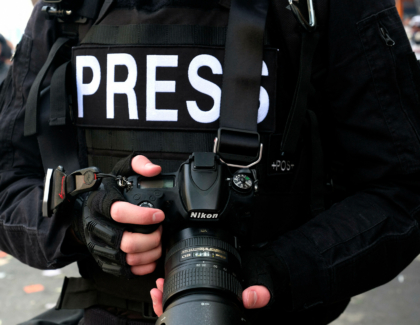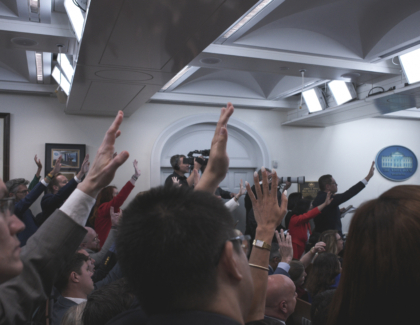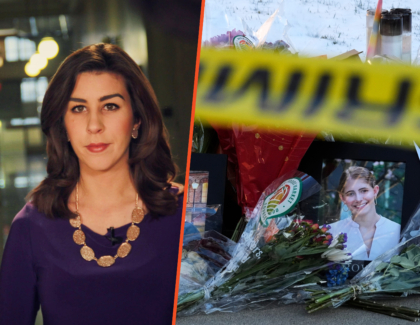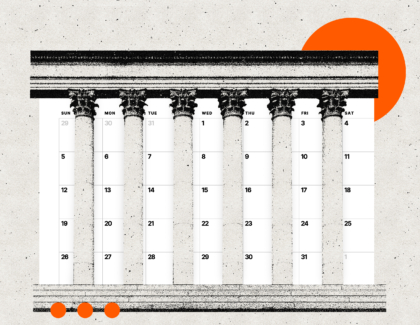Sign up for the daily CJR newsletter.
After six months of reporting, Jamie Thompson was lost. The Dallas-based freelance reporter had spent half a year on what would become her pièce de résistance, but struggled with how to structure it. So she turned to Mike Wilson, the editor of the Dallas Morning News. They started meeting at Cindi’s New York Deli and Bakery, around the corner from the News office, to sift through Thompson’s material. They brainstormed ledes, shared updates, and exchanged ideas over plates of scrambled eggs and pots of coffee. The result of those early morning breakfasts? An incredible reconstruction of one of the most tragic days in recent Texan history.
Published online February 2nd (and in print this past Sunday), “Standoff” gives a real-time account of the July 7, 2016 shooting of police officers in Dallas. It’s the only behind-the-scenes look at how the Dallas SWAT team ultimately cornered and killed the shooter, who took the lives of five officers and injured several others. Through hours of interviews, photographs, public documents, and archival audio, Thompson recreates the tragic night, the details of which have been murky until now.
ICYMI: An ongoing feud between two media goliaths
In the early evening of July 7, protesters gathered in downtown Dallas in response to the killing of two men—Alton Sterling and Philando Castile—by police officers in Louisiana and Minnesota, respectively. The protest was one of several happening across the United States, and there were no initial reports of any incidents. That changed at 8:58pm, when Micah Xavier Johnson, known as “X” in Thompson’s story because that’s the name he gave one of the officers, opened fire as the otherwise peaceful protest came to a close, specifically targeting members of the Dallas police force. The ambush, which spanned several hours, ended with his death, plus the deaths of five cops; another nine officers and civilians were injured. “The power of this story is that for a lot of readers, the difference between what they know now and what they did then is tremendous,” Wilson says.
The power of this story is that for a lot of readers, the difference between what they know now and what they did then is tremendous.
Thompson, who is on contract with the News, details the standoff between the Dallas police and X as he fled the scene of the initial firefight and sought cover inside El Centro College a few blocks away. She wanted to know the full story of what happened inside the building: the key players, the decisions made, the gunman’s route. Most reporters wrapped up coverage of the shooting in the weeks following the tragedy, but Thompson stuck with it. She started ride-alongs and informal conversations with countless members of the Dallas police in September 2016. Officer by officer, she cultivated a sense of trust with the Dallas police. It took a long time, but she eventually landed her first on-the-record interview in May 2017—a full nine months after she started the process. Only one officer asked for a nickname to be used instead of his full name, fearing for his family’s safety.
At the same time, Thompson also filed requests for documents, like department emails from the day of the shooting, which helped her fill in gaps of the story. None of the city’s audio or video from that night, however, has been publicly released—not even after Thompson’s diligent follow-ups. “This is probably one of the best documented [incidents], but none of that is out,” she says. So her piece became a wholly oral account, one that was fact-checked and updated up until the day it published. She did find and verify some amateur audio recordings of the police scanner from that night, and she received some audio recordings belonging to Larry Gordon, the officer who negotiated with the gunman. He recorded 26 minutes of audio on his phone from the scene. Gordon’s experience became the through-line of the whole piece, starting in the midst of negotiations, then circling back to the beginning of the day. At times, Thompson directly pulls dialogue from his audio.
ICYMI: A bombshell scoop that started with an 11-word, late-night text
Since Thompson relied mostly on firsthand accounts, she modified her approach to fact-checking, under the supervision of her editor, Wilson. She wanted to get it right, and so she would read sections of the piece to the officers, with the caveat that she and her editor maintained final control. With so many moving parts, plus a minimal paper trail, it was the best way to ensure accuracy after dozens of hours of interviews.
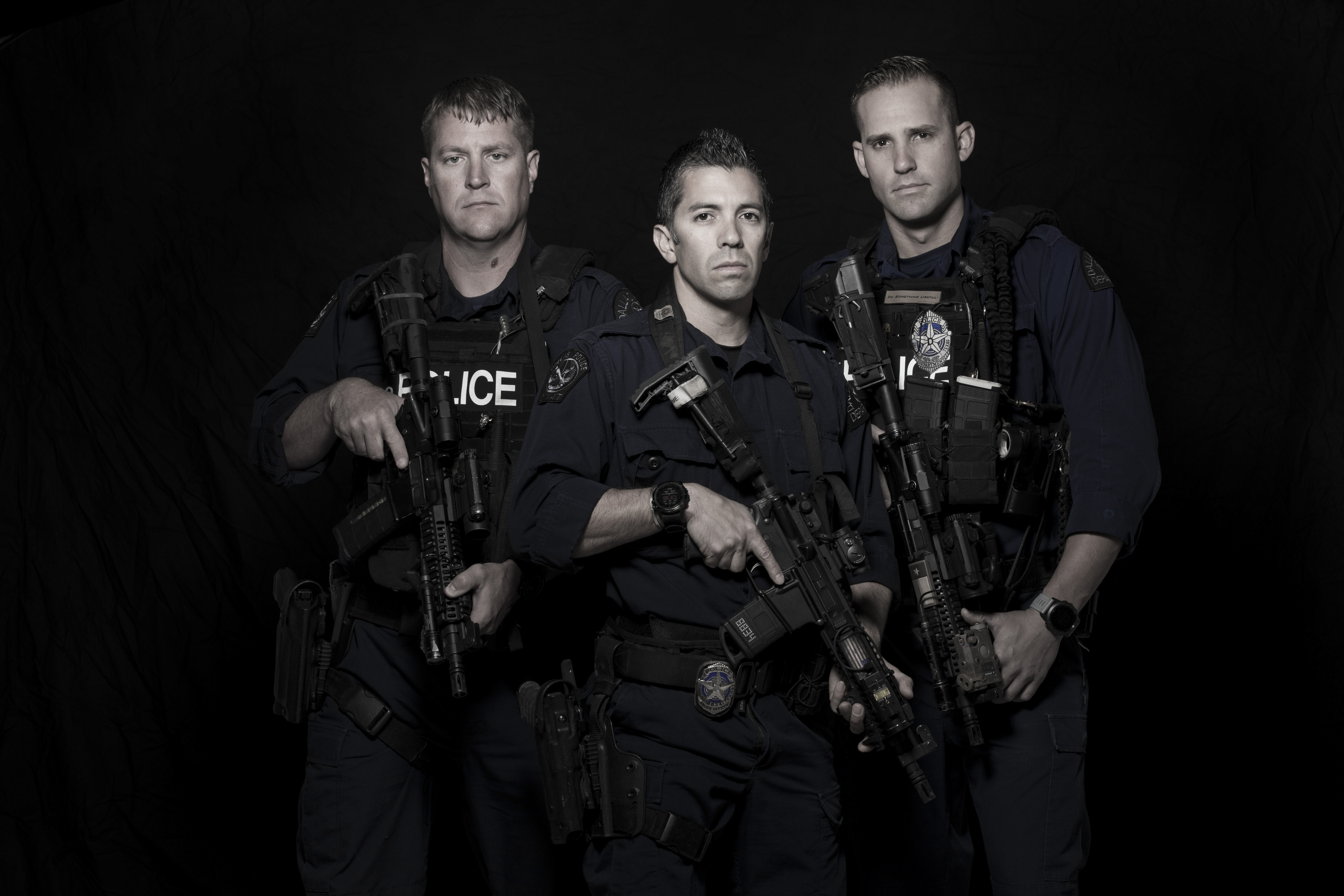
DPD SWAT team members, from left, Sr. Cpl. Ryan Scott, Sr. Cpl. Danny Canete and Sr. Cpl. Brandon Berie photographed in the DMN studio. Photo credit: Smiley N. Pool/The Dallas Morning News
To help readers keep track of all the different characters, Thompson and Wilson decided to create mini-profiles, complete with portraits and bio, of “the ensemble cast,” in Wilson’s words. The almost 13,000-word article also contains a number of sections that read like vignettes, for example, “Three Amigos,” which introduced three of the SWAT members (and also best friends), Danny Canete, Ryan Scott, and Brandon Berie. “I think that happens naturally,” Wilson says. “The action happened in pockets either defined by one person or based on the location of what was happening.” The newspaper’s staff artist, Michael Hogue, also got creative with visual representations of key moments that night. He sketched the gunman’s path of terror and the hallway of the shootout, for example, to help orient the reader in time and space.
I knew there was a lot more on the table. I never lost interest in this one.
So far, the reception has been overwhelming. “The time people are spending on story is extraordinary, unlike anything we’ve seen,” Wilson says. An average story on the News website gets anywhere between 3,000 and 4,000 views, with some hitting 20,000 on occasion—this piece has 100,000 and counting. For Thompson, who covered the shooting for the Washington Post, the reception is validation. “I knew there was a lot more on the table,” she says. “I never lost interest in this one.”
ICYMI: The photographer behind the emotional Dallas shooting image is an intern—but he’s no novice
Has America ever needed a media defender more than now? Help us by joining CJR today.




